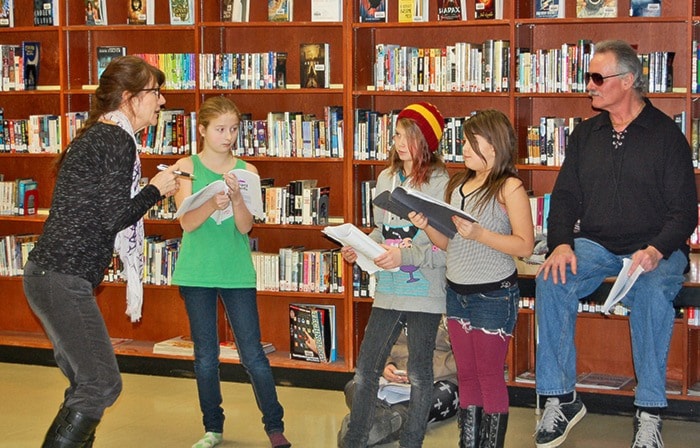Wherein we follow the Winding Rivers Arts and Performance Society as it puts on a show. . . .
Jan. 20: The first rehearsal is a chance for the actors to get up on stage and see how it feels. In our case, the “stage” is a section of floor in the library at Ashcroft Secondary School, which has been measured and marked to conform to the space we’ll have on the real stage in the Community Hall. Stage Manager Jessica Clement has also used masking tape to show where the entrances are, so we can get used to going in and out at the right places.
We spend this rehearsal working on the crucial matter of “blocking”, which is what dictates every movement an actor makes on stage, from the moment she enters to the moment she exits. If left to their own devices, most actors would either plant themselves in a given spot on stage and stand there to deliver all their lines, regardless of what else was going on around them, or wander aimlessly about, bumping into things and getting in people’s way. It’s up to the director to ensure this doesn’t happen; hence blocking, which requires the skills of a choreographer, a traffic cop, and a visual artist.
The choreography is to ensure that everything flows and looks natural, while at the same time getting characters from point A to point B at the right time for exits, entrances, and interactions with other people (when the dialogue indicates that George slaps Principal Darling on the back, those two actors better be standing pretty close to each other, or things will get awkward). The traffic cop comes into play when there are several characters on stage at once, to ensure no one is standing in front of someone else and obscuring them from the audience. It’s also helpful in moving people along from just inside the entrances, otherwise you can quickly end up with a traffic jam. And the eye of a painter or photographer is useful, so that the people on stage are grouped in ways that are visually pleasing and balanced, rather than just standing in a long row, or bunched up together in one spot.
Blocking is a fairly intensive process; almost every line that’s delivered is a cue for our director, Mavourneen, to stop whoever’s speaking and indicate to the people on the stage where they should be or move to. It takes almost 100 minutes to block a section of play that will take just over 30 minutes to perform, and we know that there will be tweaks to what we’ve just blocked as the rehearsals progress and Mavourneen gets a better idea of how she wants things to look.
We’re also busy tweaking the Americanisms in the play, and replacing them with Canadian references. The Internal Revenue Service becomes Revenue Canada, the FBI is transformed into the RCMP, and a governor becomes a senator (which allows us to insert a topical reference to our current senate scandal). The most difficult adjustment is to the fact that Jake the security guard is now Jackie; all references to him and he and sir (and of course Jake) have to be changed to her and she and ma’am and Jackie, which is harder than you’d think.
Jan. 21: More blocking; but there’s light at the end of the tunnel.
Jan. 25: Time to see how much blocking we can recall, as we take it from the top. There are still pauses to fine-tune a few things, but this time we progress through the script much faster, which is cheering. It becomes apparent that the last scene is going to need all of Mavourneen’s skill at handling a large group of people; most of the 21 cast members are on stage together at one point, so there’s not a lot of room for error. In fact, there’s not a lot of room, period. I can see more tweaks coming soon...
Barbara Roden
